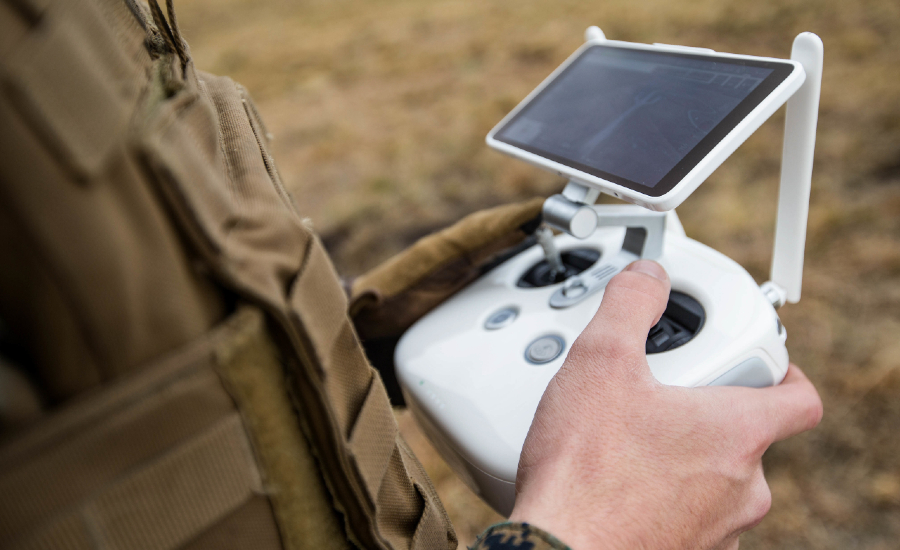Anticipating Future Directions of Tech-Enabled Terror
Counterterrorism experts need to get ahead of the curve of terrorist innovation with new, commercially-available products.

Published by The Lawfare Institute
in Cooperation With

Editor’s Note: In their desperate search for advantage, terrorists often use new technologies or employ old technologies in new ways. They frequently bungle the job or otherwise fail, but when they innovate successfully it can prove devastating. Don Rassler and Muhammad al-`Ubaydi of the Combating Terrorism Center at West Point identify innovation pathways that terrorists might follow and how counterterrorism officials might anticipate these.
Daniel Byman
***
The use of explosive-laden quadcopter drones to try to assassinate the Iraqi prime minister, Mustafa al-Kadhimi, at his residence in November was yet another wake-up call about the utility of small drones to armed non-state groups and the dangers they pose when operated by people who embrace violence to effect change. Even though Kadhimi survived the assassination attempt, which Iraqi and U.S. authorities have tied to Iranian-backed proxies, the explosives used were powerful enough to injure seven of his bodyguards and inflict visible damage to his residence. According to press reports, the attack involved at least two, and potentially three, armed quadcopter drones. And as researchers at the Washington Institute for Near East Policy have pointed out, the attack was just the latest in a series of attacks and incidents involving similar quadcopter drones that have occurred in Iraq since July 2020.
The assassination attempt is also tied to a much longer arc of terrorist interest in and use of drones that stretches back more than 25 years. Across that span of time there have been important points of innovation, and key non-state actors have played an outsized role in advancing the small drone threat. One of those key organizations is Hezbollah, an Iranian proxy that made headlines in 2004 when it first flew a drone across Lebanon’s southern border into Israel, a feat it has repeated multiple times. The Islamic State also greatly contributed to another key shift in the threat. It demonstrated that commercially acquired drones could be creatively and cheaply weaponized, and that it was possible for an organization operating under considerable pressure to acquire and deploy a fleet of commercial drones at scale. The recent string of drone attacks attributed to the Houthi movement, including incidents involving multiple drones and reported long-range flights, are another powerful reminder about the violent non-state actor drone threat, how key groups continue to advance what is possible, and the plethora of vulnerabilities small drones can exploit.
To those who have been following the non-state actor drone threat, it seems obvious that the actions of entities like Hezbollah, the Islamic State and the Houthis will continue to inspire other non-state actors and proxies to follow suit, innovate and take the terror drone threat in new directions. If that future is not here already, it is coming soon, as the dangers posed by commercial and small drone weaponization is likely to get worse and more complicated before states can devise and deploy effective and affordable ways to prevent and counter the threat. Ongoing advancements in technology have meant that commercial drones are becoming more sophisticated, capable and easier to use. The accessibility of commercial drones and other supportive technology, and the broader shift from the closed technological revolution to an open one, compounds the challenge.
Given how hard it can be to identify, provide coverage against and counter small drones, a key concern is that in the near future the limit on what non-state actors and proxies might be able to achieve with drones may be only their own creativity and imagination—and how effectively they are able to operationalize those novel and unique ideas. The Islamic State’s experience with drones, and how the world arrived at the Islamic State drone threat, offers some important lessons that can be leveraged to help understand how non-state groups might utilize and make creative use of commercial technologies and systems to innovate in the future. Understanding how the Islamic State and other groups have developed and used drone technology is critical, but analysts need to go further to extrapolate about potential terrorist innovations and prepare for them. In particular, five windows on terrorists’ use of new technologies provide important insights for anticipating new threats.
Failed Experiments
One core way to better anticipate how terrorists might creatively use new technology in the future is by understanding terror groups’ failed experiments. For example, to anticipate future weapons or plot pathways that the Islamic State might take, it would be helpful to learn more about areas where key innovation nodes, like the Islamic State’s Military Manufacturing and Development Committee (MMDC), experimented with weapons and technology but did not operationalize those ideas. Despite the principal role MMDC played in Islamic State innovations, including weaponized drones, little is publicly known about the structure of MMDC, how it operated, its areas of focus, the capabilities it sought to develop and the innovations for which it was responsible. This is unfortunate because MMDC serves as a window into the inner workings of the Islamic State, the group’s innovative capacity and the potential ways the group might strike next.
Looking at failed or novel attack pathways that extremists have explored but not pursued can also provide insight in other functional threat areas. Want to anticipate how tomorrow’s terrorists might use chemical or biological weapons? A useful reference point is the alternative attack options that the apocalyptic Japanese group Aum Shinrikyo—which successfully deployed sarin gas in the Tokyo subway in 1995—considered but did not advance due to technical difficulties or other trade-offs. Advancements in technology and access to data and technical know-how might make what Aum Shinrikyo could not achieve two decades ago possible tomorrow.
Interplay Between Defensive and Offensive Innovations
Defensive forms of innovation provide a second window into how terrorists might go on the offense. In 2012, for example, the Combating Terrorism Center observed more discussions taking place on jihadist forums that explored how groups like al-Qaeda could counter the United States’ use of armed drones through countersurveillance tools, tradecraft and other approaches. Those discussions also made clear that forum participants were attempting to crowdsource ideas for how drones could be used offensively. Those signals pushed us to map out all known instances of terror group interest in or use of remotely piloted aircraft, so we could establish a baseline for the terror drone threat. The investment paid off, as by the time the Islamic State first used a drone to kill in 2016, we had been investigating the topic for years.
Asymmetric Mirror-Imaging
A third area that can provide purchase into where and how terrorists might leverage technology to strike in novel ways are the areas where state actors have innovated. Over the past two decades, terrorists have sought to asymmetrically mirror image, or create their own versions of, new tools and weapons systems that technologically advanced states have used against them. The United States’ use of armed drones as a key weapon in the war on terror and the creative way the Islamic State modified stock commercial quadcopters to make crude bomb-drop-capable versions is one important example.
The weapon system and novel approach that was used in the fall of 2020 to assassinate Iranian nuclear scientist Mohsen Fakhrizadeh in Iran may prove to be too alluring for terrorists or Iranian proxy agents not to replicate in an asymmetric way. According to public news reports, Fakhrizadeh was killed as his car passed by a truck containing a concealed machine gun that was remotely controlled, potentially by an operator or cell located outside of Iran. Once Fakhrizadeh’s car, whose movement was reported to be tracked by satellite, arrived at the location where the prepositioned machine gun was hidden, the weapon let loose, killing him. Given what has been reported about the technology and systems used in that operation, it is unlikely that an exact replication of that attack is possible for a terror group or proxy actor to achieve tomorrow, but a simpler or creative do-it-yourself version might be possible. Western governments should not be surprised if and when a terror group tries to mimic the weapon and approach used in the attack. The Islamic State, for example, has experimented with robotics and remotely operated weapons for years, with mixed success. A propaganda video released by the group in 2017 showed an Islamic State member operating a sniper rifle via remote control. A state-assisted Iranian proxy militia group might be able to deploy a more advanced system, and a successful use of such a weapon would have serious practical and symbolic implications.
Screen grabs from a propaganda video released by the Islamic State in 2017.
Like the Islamic State’s modified drones, the asymmetric versions of these remote-controlled weapons will not look the same as the weapons that states have been able to create, nor will they be as capable, but they only have to be as sophisticated as is needed to surprise and harm the intended target or obtain other goals like publicity for the attack.
Hobbyist Innovation
Hobbyists are a creative bunch. They are resourceful and are aware of new product releases relevant to their hobby of interest. They also often like to tinker and experiment. Unlike terror groups, hobbyists do not like to harm innocent civilians, but the creative ways that hobbyists test and play with specific types of technology can also overlap with, or be useful to, those who are interested in using technology and commercial equipment for harm. An example brings the utility into focus. In 2008, a video was posted online by hobbyist Jim Simmons of a remote-controlled helicopter that had been modified with an attached handgun. The video showed the device flying in the air and successfully firing the pistol via remote.
Screen grab from a video released in 2008 that showed a handgun being fired from a remotely piloted helicopter.
Seven years later, a teenager from Connecticut posted a video online of a similar achievement: the remote firing of a handgun attached to a commercial quadcopter. Then, to up the ante, that same teenager created a homemade flamethrower, which he attached to another quadcopter drone, so he could roast a Thanksgiving turkey in his backyard. These incremental innovations were posted to sites like LiveLeak and YouTube. Simmons’s feat was a leading-edge indicator of what was possible on the terror drone front, and a key sign of the future that would arrive years later.
Some terror networks have recognized the value of observing how hobbyists innovate and tinker with drones. For example, there is evidence that supporters of the Islamic State and al-Qaeda monitor hobbyists’ Telegram channels devoted to remote-controlled airplanes. The interaction between the hobbyist space and extremist networks can also be seen in the case of Timothy Watson, who was charged in November 2020 with manufacturing and selling 3D-printed “drop in auto sears”—marketed as “detachable wall hangers”—to domestic government extremists, including to members of the boogaloo movement. The simple 3D-printed component Watson sold raised concerns because it enabled the user to “convert semi-automatic AR-15 rifles to fully automatic machine guns.”
Screen grab of “Roasting the Holiday Turkey,” YouTube/Hogwit
Enhancements for Commercial Products
A fifth window into future terrorist use of technology can be found by considering how enhancements made to commercial products can broaden or provide new attack pathways associated with tools terrorists have already used. Ongoing improvements made to commercially available drones that allow those drones to fly farther, faster, for longer and in more sophisticated ways is a useful case in point. The Islamic State’s weaponization of commercial drones, and the ongoing global diffusion of that threat, has made it clear that accessible commercial drone products can help non-state actors repurpose those systems for a variety of uses.
DJI’s FPV Drone, Control and FPV Goggles
As the technology and capabilities of commercial drones evolves, so will opportunities for terrorists to exploit those advancements to achieve their own goals. DJI’s FPV (first-person video) drone, which the company released this year, highlights the threat. Stock out of the box DJI’s FPV drone can fly 89 miles per hour at an advertised range of 10 miles. The drone also has a feature that allows it to “pause” and immediately hover. For an actor interested in penetrating drone defenses and countermeasures to conduct a speedy surprise attack to assassinate or injure a high-profile figure, an easy-to-use drone racing platform like the FPV drone would be a good stock platform to try to modify to obtain that objective. It costs $1,200 on Amazon.
Putting the Pieces Together
It will always be hard to predict the new and innovative ways terrorists might use technology to conduct future attacks, but there are indicators that allow the counterterrorism community to gain insight into areas of extremists’ interest. This information can be leveraged to better anticipate how violent non-state actors might use specific types of technology. To assess terrorists’ baseline interest and capabilities, a useful starting point for functional threats is to map those threat vectors across time, groups, ideological orientation and geography.
Here again the Islamic State’s use of drones is instructive. If this approach had been taken prior to the group’s creation of its caliphate in June 2014, it would have been clear that terrorist interest in drones had a good bit of history behind it. Mapping threat vectors would have revealed five concerning aspects of drone use that terror groups had demonstrated interest in prior to the Islamic State’s broad use of them. These five areas included interest in using drones to disperse chemical and biological weapons (Aum Shinrikyo in 1993), use of drones for cross-border missions (Hezbollah in 2004), a desire to weaponize (multiple cases), the existence of at least two terror drone programs (Hezbollah and Hamas), and the interception of drone feeds (various cases). With the recent advances that terrorist groups have made in employing these technologies, it is important to revisit this baseline and update it with new developments.
After a baseline view of a functional threat has been established, the five windows into terror innovation—failed experiments, interplay between defensive and offensive innovations, asymmetric mirror-imaging, hobbyist innovation, and enhancements for commercial products—could then be used to enrich this foundational picture. Noteworthy incidents and insights from those five areas would provide additional layers to allow analysts to better track and anticipate relevant changes taking place across an innovation ecosystem comprising terrorist, hobbyist, industry and state activity. Such an approach would help governments better prepare for new, creative and innovative approaches that terrorists might use tomorrow and in the years ahead.






